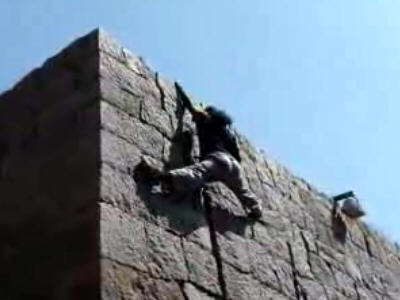The trip to reproduce Ieyasu Tokugawa's 'Iga Goe' on foot ended in failure, so I thought about why Ieyasu was accomplished

Ieyasu Tokugawa, who heard the news of the incident at Honnoji
◆What is Iga-goe?
When Oda Nobunaga was killed in the Honnoji Incident, Ieyasu was sightseeing around Sakai (present-day Sakai City, Osaka Prefecture). When Ieyasu moved from Sakai to Shijonawate-jinja Shrine located in Shijonawate City, Osaka Prefecture, he heard the news of the incident at Honno-ji Temple, and from there he returned to Okazaki-jo Castle located in Okazaki City, Aichi Prefecture via Iga in three days. It is transmitted. This great migration has been handed down to the present day as ``Iga-goe'' or ``God Iga-goe'', but was it really possible to ``move from Shijonawate Shrine to Okazaki Castle in a short period of 3 days''? I was curious, so I decided to try to reproduce the itinerary on foot.
The planned route of the Iga crossing reproduction trip and the training record for the reproduction are summarized in the following article.
Ieyasu Tokugawa is in a big pinch at Honnoji Incident and goes on a journey to reproduce 'Iga Goe', which returned from Osaka to Aichi with explosive speed on foot - GIGAZINE

Reproduction of Iga-goe ended in failure
On the first day of crossing Iga, we took a slightly different route than planned, but succeeded in reaching our destination, Yamaguchi Castle, after walking 31km. However, when I entered Koka City on the second day, I started to feel pain in the soles of my feet, and I could only walk at a slow pace, taking five hours to cover 12.5km. After all, on the second day, we were only able to proceed about half of the planned route, and had to change buses and trains to head to our accommodation. The progress of the second day is summarized in the article below.
Trouble occurred on the second day of the trip to reproduce 'Iga-goe' on foot [Day 2: Yamaguchi Castle - Ogawa Castle Ruins] - GIGAZINE

After that, after one night, the pain in my leg seemed to subside, but after walking about 500m to the nearest station to my accommodation, the pain recurred. bottom.

The route I walked by the 3rd day is as follows. Since the route cannot be completely reproduced on Google Maps, there is a gap in the distance, but the distance traveled is 53.2 km, and the final destination is Koka. I couldn't even enter Iga, let alone cross Iga. According to ``History of Japan'' written by the missionary Luis Frois, Anayama Baisetsu, who dropped out of Ieyasu's ``Iga Crossing'' party, was killed in a hunt for fallen warriors. It may not have worked.
Why did you fail to cross Iga?
The biggest reason why I couldn't reproduce the Iga-goe was 'pain on the soles of my feet.' Other causes such as heat stroke and lack of physical strength are also considered, but the possibility of heat stroke is low because water and salt were frequently replenished. Also, when the soles of my feet hurt, I wasn't out of breath, so the lack of physical strength seems to be thin. So, when you think about why the soles of your feet hurt, the following factors are listed.
・Insufficient measures against asphalt
The recreated Iga-goe route consists of asphalt-paved roads, with the exception of a very small portion. The hardness of this asphalt must have been gradually hurting my feet.

The fact that even after my feet started hurting, the pain in my feet eased on dirt roads also supports the theory that asphalt hurts my feet.

I knew that hard asphalt put a lot of stress on my feet, unlike mountain trails. This probably wasn't enough.

Unable to withstand the daily load
I did some running and mountain climbing in preparation for the challenge of crossing Iga, and I thought I had enough physical strength. In addition, assuming the actual crossing of Iga, I was confident in my stamina when carrying heavy luggage on my back and walking 18.1 km on a road with an altitude difference of 1800 m.

However, I ran about once every three days, and I only climbed mountains once. . In order to succeed in crossing Iga, not only simple physical strength but also resilience to make a full recovery by the next day is necessary.
Why was Ieyasu Tokugawa able to cross Iga?
I tried to think about why Ieyasu was able to accomplish the Iga crossing based on the factors of the failure to reproduce the Iga crossing.
・Was Ieyasu healthier than modern people?
In a Q&A on the Tokaido, the Yokohama National Highway Office
・Did Ieyasu ride a horse?
In the first place, Ieyasu himself did not always cross Iga on foot. In fact, at Yamaguchi Castle, which is on the route, there was a description on the information board that ``I changed horses here.'' The source is 'Ujitawara Town History', and at least it can be said that there was a legend that 'Ieyasu was riding a horse' in Ujitawara. However, this is a conclusion that the challenge on foot becomes meaningless, so if possible, I would like you to run desperately like Ieyasu Tokugawa played by Seiyo Uchino in the Taiga drama 'Sanada Maru'. is.

In this trip to recreate the crossing of Iga, I learned that it would be impossible to cross Iga on foot with the physical strength that would take an hour to run 10km. I want to train my body and challenge Iga crossing again someday. Also, knowing that crossing Iga on foot is quite difficult, I would like to pay attention to how Tokugawa Ieyasu's crossing of Iga, played by Jun Matsumoto in the Taiga drama Dosuru Ieyasu, will be portrayed.
Related Posts:
in Coverage, Posted by log1o_hf





